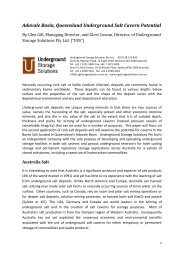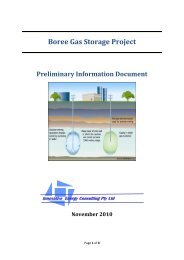Natural gas storage in salt caverns present trends in Europe
Natural gas storage in salt caverns present trends in Europe
Natural gas storage in salt caverns present trends in Europe
You also want an ePaper? Increase the reach of your titles
YUMPU automatically turns print PDFs into web optimized ePapers that Google loves.
GILLHAUS, A. (2007): <strong>Natural</strong> <strong>gas</strong> <strong>storage</strong> <strong>in</strong> <strong>salt</strong> <strong>caverns</strong> – Present status, developments and future <strong>trends</strong> <strong>in</strong> <strong>Europe</strong><br />
<strong>in</strong>creases the importance of natural <strong>gas</strong> <strong>storage</strong> to ensure supply security (e.g.<br />
BARBKNECHT 2006).<br />
The natural <strong>gas</strong> <strong>storage</strong> volume <strong>in</strong> 20 countries <strong>in</strong> <strong>Europe</strong> <strong>in</strong> 2006 was almost 80 billion m 3<br />
(Vst work<strong>in</strong>g <strong>gas</strong>). This was stored <strong>in</strong> porous and cavern <strong>storage</strong>s, and accounts for<br />
approx. 15 % of the annual demand. The largest shares of the total stored volume <strong>in</strong><br />
<strong>Europe</strong> are found <strong>in</strong> Germany (19 billion m 3 Vst), Italy (17 billion m 3 Vst) and France (11<br />
billion m 3 Vst) (IGU 2006, SEDLACEK 2006). This disguises, however, the huge variation <strong>in</strong><br />
the proportion of <strong>storage</strong> capacity to total consumption <strong>in</strong> each <strong>Europe</strong>an country (Fig. 1):<br />
Latvia’s <strong>storage</strong>s for <strong>in</strong>stance account for more than 100 % of annual natural <strong>gas</strong><br />
consumption, whilst the <strong>storage</strong> volume to annual demand ratio of only 4 % <strong>in</strong> the UK is<br />
the lowest proportion <strong>in</strong> <strong>Europe</strong>.<br />
Figure 1: Specific <strong>storage</strong> capacity of some <strong>Europe</strong>an countries (modified from<br />
web.w<strong>in</strong>tershall.com).<br />
Gas <strong>storage</strong>s are primarily built to balance out the strong fluctuation <strong>in</strong> seasonal demand,<br />
and for peak shav<strong>in</strong>g. Storages are important for establish<strong>in</strong>g cont<strong>in</strong>uous supply and<br />
production from remote <strong>gas</strong> fields and to optimise the efficiency of the pipel<strong>in</strong>es. Gas<br />
<strong>storage</strong>s are also vital for strategic <strong>gas</strong> purchas<strong>in</strong>g, secur<strong>in</strong>g <strong>gas</strong> supplies, and bridg<strong>in</strong>g<br />
technical or political shortfalls <strong>in</strong> deliveries.<br />
The dynamic growth <strong>in</strong> <strong>storage</strong> capacities currently tak<strong>in</strong>g place <strong>in</strong> <strong>Europe</strong> reflects a<br />
number of different factors:<br />
• The decl<strong>in</strong>e <strong>in</strong> <strong>gas</strong> production <strong>in</strong> the UK means that the country is chang<strong>in</strong>g from a<br />
<strong>gas</strong> exporter to a net <strong>gas</strong> importer, a situation which requires <strong>storage</strong>s (currently<br />
only account<strong>in</strong>g for approx. 4 % of annual consumption)<br />
• Liberalisation of <strong>gas</strong> trad<strong>in</strong>g has <strong>in</strong>itiated a demand for trad<strong>in</strong>g <strong>storage</strong>s<br />
page 3 of 18










